
views
X
Research source
In this article, we’ll show you several easy ways to remove rust from cast-iron, stainless steel, non-stick, and other metal cookware with products you likely already have at home. Then, we’ll tell you how to prevent rust from forming in the first place. Read on to learn how!
- Wet non-stick, stainless steel, and cast-iron cookware with water, coat it with baking soda, and let it sit for 30 minutes. Then, scrub it with a sponge.
- Alternatively, sprinkle stainless steel and cast-iron cookware with coarse salt and scrub it with a potato or lemon.
- For cast-iron cookware, soak it in equal parts white vinegar and water for 1 hour.
Removing Rust with Baking Soda
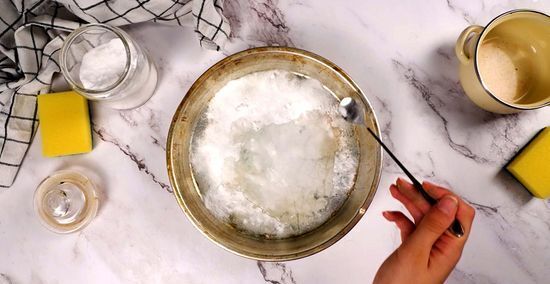
Wet your cookware and sprinkle baking soda on the rusty spots. Baking soda is a natural, mildly abrasive cleaner that dissolves and lifts off rust. Just run your pot, pan, or baking sheet under water and shake off the excess moisture. Then, apply a thin layer of baking soda to the inside, sides, and bottom of your cookware where you see rust. Wetting your cookware helps the baking soda stick to your pot or pan and create a paste. Baking soda removes rust on non-stick, stainless steel, cast-iron, and other metal pots, pans, cookware, and baking sheets.
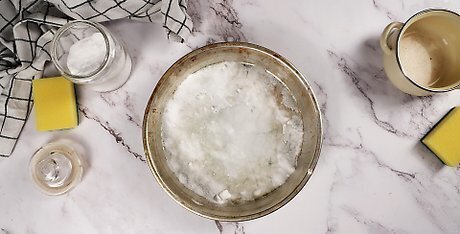
Let the baking soda sit for 30 minutes. Give the baking soda ample time to cut through the rust and work its cleaning magic. Just set a timer for 30 minutes and leave your pot, pan, or baking sheet be. For extra cleaning power, pour a little bit of white vinegar onto the baking soda. This creates a bubbling reaction that helps dissolve the rust.
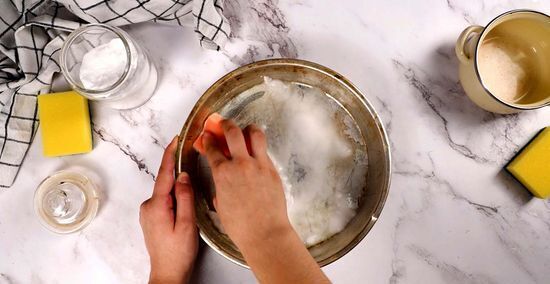
Scrub the baking soda and rust with a scrubbing sponge. Take a scrubbing sponge or scouring pad and rub it into the baking soda and rusty spots using circular motions. If you’re dealing with a lot of rust, use firm pressure and some elbow grease to remove the spots. For cast-iron cookware: Scrub with steel wool if you’re dealing with severe rust. Do not use steel wool on stainless steel or non-stick pots and pans, as it can scratch and damage the metal. Instead, stick to a sponge or toothbrush. Or, scrub with a potato. Potatoes contain oxalic acid to help dissolve rust. Just cut any potato in half and rub the cut end into the baking soda and rust.

Wash your pan with soap and water and dry it off with a towel. Rinse off the baking soda and rust debris by running your pot or pan under water and cleaning it with dish soap. Then, dry your cookware with a clean kitchen towel. If you still see spots of rust after rinsing off your pot or pan, repeat the steps above to remove the rest of the rust. For cast-iron: Rinse the pan under water without soap. Dry it on the stove over medium-low heat. Then, season your pan by pouring a dollop of vegetable oil into the pan and rubbing it into the inside, sides, and bottom with a paper towel. Then, heat your pan in the oven for 1 hour at 350 F (177° C).
Soaking Cast-Iron and Carbon Steel in Vinegar
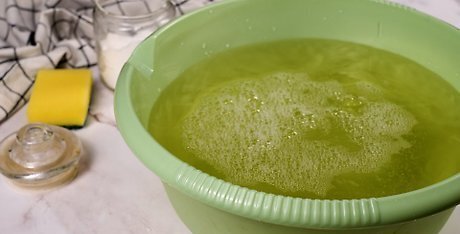
Fill your sink or a container with equal parts white vinegar and water. White vinegar contains acetic acid which dissolves and removes tough spots of rust on your pots and pans. Just fill your sink or a container large enough to hold your cast-iron or carbon steel cookware with 50% white vinegar and 50% water.

Soak your pot or pan in the vinegar solution for 1 hour. Set your cookware in the vinegar and water mixture, ensuring all of the rusty spots are covered. Then, leave it in the solution for at least 1 hour to allow the vinegar to soften and lift off the rust. For severe rusting, leave your pot or pan in the solution for up to 5 hours. If you have a light layer of rust, simply spray your pot or pan with a mixture of equal parts vinegar and water. Then, let the solution sit for 10 minutes.
Scrub your pot or pan with a sponge or steel wool. Lift your pot or pan out of the vinegar solution and clean off the rust debris. If you’re dealing with minimal rust, rub the pot or pan with a scrubbing sponge. If your cookware is covered in rust, scrub it off with a steel wool pad. EXPERT TIP James Sears James Sears Professional Cleaner James Sears leads the customer happiness team at Neatly, a group of cleaning gurus based in Los Angeles and Orange County, California. James is an expert in all things clean and provides transformative experiences by reducing clutter and renewing your home environment. James is a current Trustee Scholar at the University of Southern California. James Sears James Sears Professional Cleaner Scrub with baking soda to remove tough rust spots. Pour the vinegar solution out of the pot or pan and sprinkle baking soda over any rusty spots. Then, use the hard side of a sponge to scrub the baking soda into the rust.
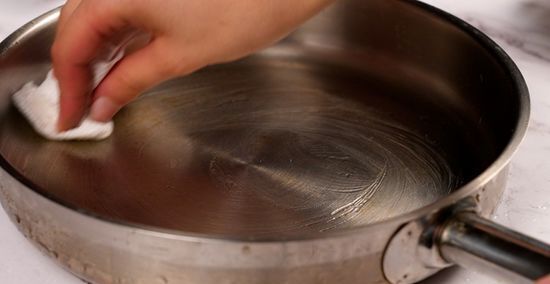
Wash the cookware with water, dry it, and season it with oil. After you remove all of the rust from your cast-iron pot or pan, rinse it off with warm water. Dry it with a kitchen towel and then set it over a medium-low stove to remove all of the moisture. Then, coat it with vegetable oil and bake it in the oven at 350° F (177° C) for 1 hour.
Getting Rid of Rust with Coarse Salt
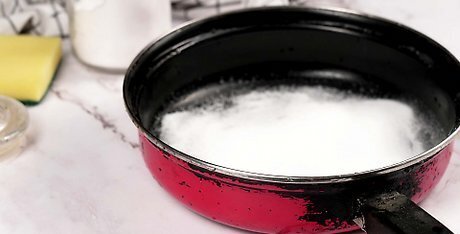
Pour coarse sea salt into the rusted pot or pan. Salt is mildly abrasive, which helps it remove tough, set-in rust. Just sprinkle enough coarse sea salt to lightly cover the rusted spots inside your pot, pan, or cooking sheet. Salt tends to be too abrasive for non-stick pans, so opt to remove any rust with baking soda instead.
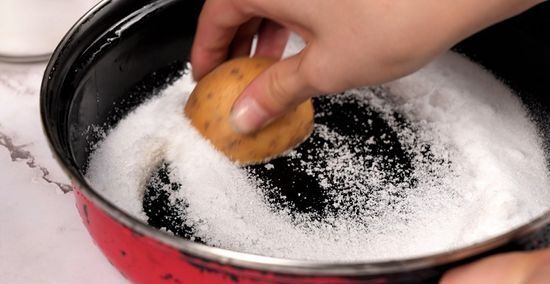
Scrub the salt and rust with a cut potato or lemon. Cut a potato in half and work the cut end into the salt. Or, scrub the rust with a lemon by slicing it in half and rubbing the cut end into the salt. Just keep scouring the pot, pan, or sheet until the rust lifts away. The citric acid in lemons works similarly to vinegar and helps dissolve rust. If your salt starts turning red or orange from the rust, simply discard it and pour a new dusting of salt into your cookware.

Clean the pan with soap and water, then dry it with a towel. Hold your pan under your kitchen sink to rinse away the salt and rust, then wash it thoroughly with dish soap and warm water. Then, dry it completely with a clean kitchen towel. For cast-iron: Rinse the pot or pan with only water. Then, dry it over the stove on medium-low heat. Season it with oil and set it in the oven for 1 hour at 350° F (177° C).
Scouring Cast-Iron with Steel Wool
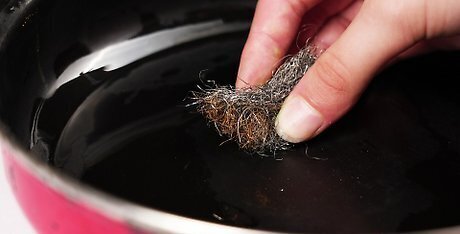
Wet your pan with warm water and scour it with steel wool. If you only have a light layer of rust in your cast-iron pot or pan, a bit of water and steel wool is typically all you need to remove it quickly. Just add a bit of warm water to your pan and scrub the spots of rust with your steel wool. Do not scrub stainless steel or non-stick pots and pans with steel wool. Steel wool is very abrasive and can scratch stainless steel or lift up the non-stick coating on non-stick cookware.
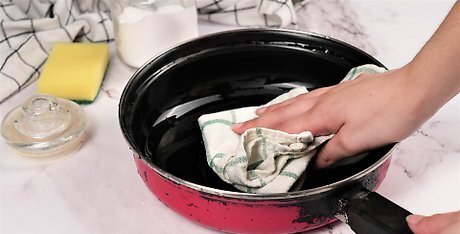
Rinse the cast-iron under water, dry it, and season it. Run your cast-iron pot or pan under water to remove and clean off any rust debris. To dry it completely, wipe it off with a towel and then place it over the stove on medium-low heat. Then, coat your pot or pan with cooking oil and bake it in the oven for 1 hour at 350° F (177° C).
Preventing Rust on Pots and Pans
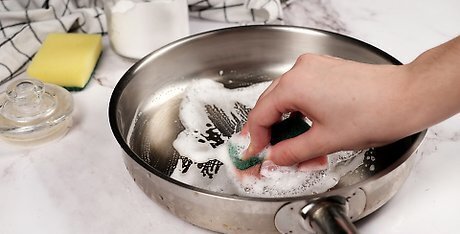
Clean your pots, pans, and other cookware after every use. Whether you’re cooking in a cast-iron skillet or a stainless steel pot, make sure to remove leftover food and oil from your cookware before storing it away. Regular cleaning prevents buildup that can lead to rust and extends the life of your pots and pans. Clean cast-iron by rinsing your cookware under water and scraping off any food residue with a scrubbing pad or sponge. Wash other metal pots and pans, like stainless steel, with dish soap and warm water. Use a scrubbing pad or sponge to scrub and remove old bits of food. Avoid putting pots and pans in the dishwasher, as the moist environment can encourage rust to form.
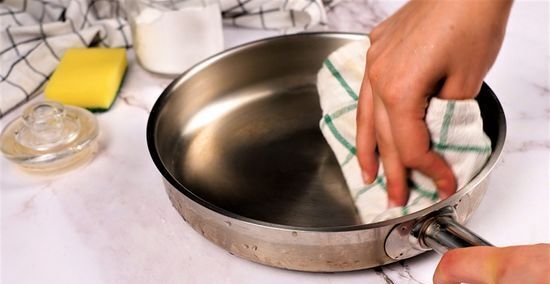
Dry pots and pans with a towel or on the stove after cleaning them. Rust, or iron oxide, forms when iron or steel is exposed to water. So, make sure your pots, pans, and baking sheets are completely dry after rinsing them off with water. Just dry them with a clean kitchen towel, or speed up the drying process by heating your cookware on medium-low heat over the stove. If you dry your cookware using heat, let it cool completely before putting it away.
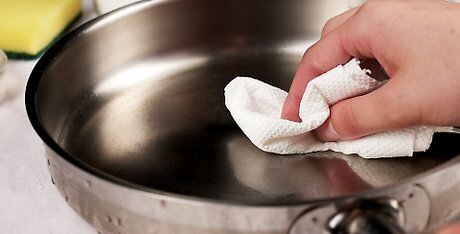
Season your metal pots and pans with cooking oil. Seasoning your cookware, or coating it with cooking oil, adds a protective layer that helps keep away moisture. Every metal pot or pan benefits from seasoning, not just your cast-iron skillets. Just pour 1 to 2 tablespoons (15-30 ml) of vegetable oil or melted shortening into your pot or pan. Then, rub the oil into the bottom, sides, and exterior of your cookware with a paper towel. If the cookware is oven-safe, bake it for 1 hour at 350° F (177° C) after coating it with oil. If the pan is not oven-safe, heat it on the stovetop until it smokes. Let your pot, pan, or baking sheet cool off before storing it.
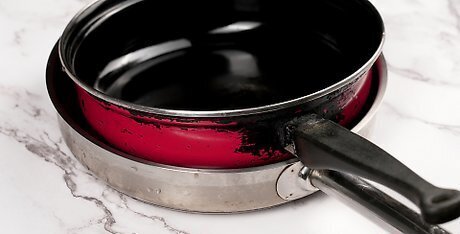
Store your pots and pans in a dry area. Whether you stack or hang your pots and pans, keep them away from moist areas in your kitchen, like near your sink or dishwasher. Just store your cookware in a dry spot, like inside your kitchen cabinets or hanging on a wall rack. If you stack your pots and pans, place a paper towel or pan protector inside each piece of cookware to absorb any moisture and prevent scratches.














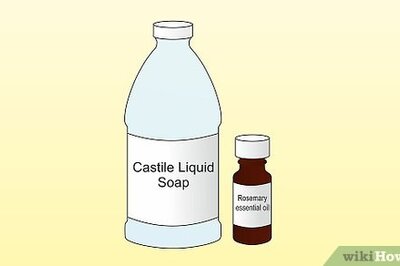




Comments
0 comment